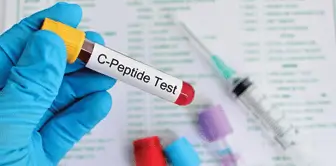C-Peptide Test: Normal Range, Low & High Levels
Sep 12, 2022

C-Peptide Test: Normal Range, Low & High Levels
The C-peptide test is used as a measure of the amount of insulin that is being produced by the body. The test measures the level of C-peptide, which is a substance, produced in the pancreas along with insulin. Both, insulin and C-peptide are released into the blood in equal amounts, at the same time, which is how this test can also show doctors how much insulin is being made by the body.
Another important use of the C-peptide test is used to diagnose whether a person is suffering from type 1-diabetes or type 2-diabetes.
Insulin is a hormone, produced by the beta cells in the pancreas, and is primarily responsible for maintaining the blood sugar levels in the blood. The food that is ingested is broken down by the body into glucose and other nutrients. The insulin is released by the pancreas to carry the glucose to the cells, where the glucose is converted into energy and stored for use. C-peptide was earlier considered to be a by-product of insulin production. However, C-peptide hIas by now proved that it may have a pro-inflammatory or anti-inflammatory effect on the body, depending on its levels.
Why is the C-Peptide Test Used to Measure Insulin Levels?
The pancreas does not produce insulin directly. Instead, the beta cells of the pancreas produce proinsulin, each molecule of which consists of an insulin molecule and a C-peptide molecule. When the blood sugar levels in the body rise both substances are released into the blood.
Released together in the same quantity, insulin and C-peptide are broken down differently. Insulin is broken down at a variable rate by the liver, while the kidneys maintain a steady rate when breaking down C-peptide. So, the levels of C-peptide are a more reliable parameter to analyse the body’s insulin production.
The C-Peptide Test for Diabetes
Diabetes is a chronic condition that affects how food is converted into energy by the body. Under this condition, the body either does not produce enough insulin or is unable to, which leads to high blood sugar levels, and can lead to serious complications over time.
Type-1 diabetes is an autoimmune disease in which the body is unable to produce insulin, which is reflected in the C-peptide levels as well. On the other hand, in type-2 diabetes, the body is producing insulin but is unable to utilise it properly. Not only can the C-peptide test help distinguish between the two; it is especially useful for diagnosing latent autoimmune diabetes in adults (LADA) or type-1.5 diabetes.
hand, in type-2 diabetes, the body is producing insulin but is unable to utilise it properly. Not only can the C-peptide test help distinguish between the two; it is especially useful for diagnosing latent autoimmune diabetes in adults (LADA) or type-1.5 diabetes.
LADA is basically type-1 diabetes that stays latent in an individual for a long time, becoming active much later, when they are adults. This often leads to LADA being misdiagnosed as type-2 diabetes, preventing the individual from getting the correct treatment for the same.
Other reasons why a doctor may prescribe the C-peptide test include monitoring diabetes to check the efficacy of the treatment plan, investigating the cause of low blood sugar (hypoglycaemia), and to check the effect of certain medications or treatment plans on the blood sugar levels.
Who Should Go for the C-Peptide Test?
A C-peptide test is prescribed to individuals who have been diagnosed with type-1 or type-2 diabetes. In type 2 diabetes, the test can be performed to monitor beta cell function and insulin production so a doctor may see whether insulin injections are required. A C-peptide test is also recommended by also if an individual is displaying symptoms of having a low blood sugar level (hypoglycaemia). These include:
- Blurry vision
- Frequent hunger and thirst
- Excessive sweating
- Lethargy
- Heart problems
- Dilemma
The C-peptide test is also performed to diagnose pancreatic tumours or to monitor recovery after the transplantation or removal of the pancreas. The test also helps assess a person’s response and weight loss after bariatric surgery and also help analyse their risk for developing diabetes, if any.
Interpreting the C-Peptide Test Results
The C-peptide levels are measured in Nano grams/millilitres, denoted by Ng/ml or Nano moles/millilitres, denoted by NMOL/ml. The normal range of C-peptide in a healthy individual should be between 0.8-3.85 Mg/ml or 0.26-1.27 NMOL/ml. However, this range may vary from one diagnostics lab to another and may vary individually based on several factors. Consulting a doctor is always the best idea for a better understanding of the results and health status.
Understanding Low C-Peptide Levels
Low levels of C-peptide mean that little or no insulin is being produced by the pancreas. There are several medical conditions that can lead to low C-peptide levels, including:
- Type 1 diabetes
- Type 2 diabetes
- Latent autoimmune diabetes in adults
- Hypoglycaemia
- Fasting for long periods of time
- Impaired pancreas function
- Undergoing insulin therapy
- Pancreas removal
Some of the most common symptoms of low C-peptide levels that include:
- Excessive hunger and thirst
- Abnormally large production or passage of urine
- Dizziness and light-headedness
- Feeling of dilemma
Understanding High C-peptide Levels
High C-peptide indicates high levels of insulin as well. It may be that the body is either producing too much insulin or that the body is unable to use the insulin properly, which leads to the glucose in the blood not getting converted into energy, subsequently leading to elevated blood sugar levels as well. The main causes of high C-peptide levels include:
- Pancreatic tumour
- Pregnancy
- Insulin resistance
- Kidney disease
- Hypokalaemia
- Cushing syndrome
- Obesity
A person with high C-peptide levels may not necessarily experience many symptoms. However, some of the most common symptoms of high C-peptide levels include:
- Weight gain around the waist
- Inflammation
- High levels of uric acid
- High levels of cholesterol and triglycerides
Generally performed after overnight fasting, C-peptide test levels are an important part of overall health management.
Related Blog Post
Blog Categories
- Child Health
- Mens Health
- Women's Health
- Mental Health
- Health Myths & Facts
- Fitness
- Nutrition/Recipes
- Remedies
- Weight Management
- Stress Management
- Health Supplements
- Addiction Management
- Disease Management
- Allergy
- Anemia
- Arthritis
- Asthma
- Autoimmune Diseases
- Blood Pressure
- Cancer
- Deficiencies
- Dengue/Malaria/Chikungunya
- Diabetes
- Eye Problems
- Heart Diseases
- Hepatitis
- HIV/AIDS/STD
- Hormonal Imbalance
- Infection/Flu/Viral
- Kidney
- Liver
- Menstrual Problems
- Pregnancy
- Skin & Hair Problems
- Stomach Ailments
- Thyroid
- Others
- Health Checkups
- Diagnostics/Pathology
- Lifestyle & Wellness
- Covid
- Medical Tests
- Cholesterol
- Health Tips
- Parent Care/Old Age
- Lungs
- Food Intolerance








